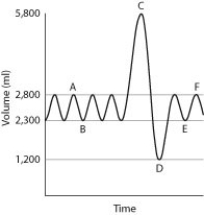Multiple Choice
Physicians routinely give their patients pulmonary function tests in order to measure characteristics of lung function. The most common of these tests, spirometry, measures both the volume and the speed of air entering and exiting the lungs. In this test, a person first breathes normally while breathing into a spirometer, a machine that measures air volume and air speed. Then the person takes the deepest breath possible and exhales as hard as possible for 6 seconds into the spirometer. The resulting data are plotted on a graph of volume (y axis) versus time (x axis) . Spirometry is useful not only for assessing lung function in healthy patients but also for characterizing patients with lung conditions such as pulmonary fibrosis, asthma, or emphysema.
A sample graph for a healthy adult male is shown below. Normal breathing occurs between points A and B, a maximal inhalation occurs at point C, and a maximal exhalation occurs at point D. Normal breathing resumes between points E and F.

-For this data set, what is the residual volume of the lungs?
A) 500 mL
B) 1,200 mL
C) 2,300 mL
D) 2,800 mL
Correct Answer:

Verified
Correct Answer:
Verified
Q19: When you are breathing normally, exhalation results
Q20: The evolution of aquatic vertebrates that could
Q21: Which of the figures shown represents countercurrent
Q22: <img src="https://d2lvgg3v3hfg70.cloudfront.net/TB6039/.jpg" alt=" Formaldehyde
Q23: When you hyperventilate (breathe too fast), respiratory
Q25: What part of the human brain contains
Q26: Sometime after a human baby is born,
Q27: Which of the following organisms has a
Q28: Which of the following statements regarding breathing
Q29: There is a condition that affects the